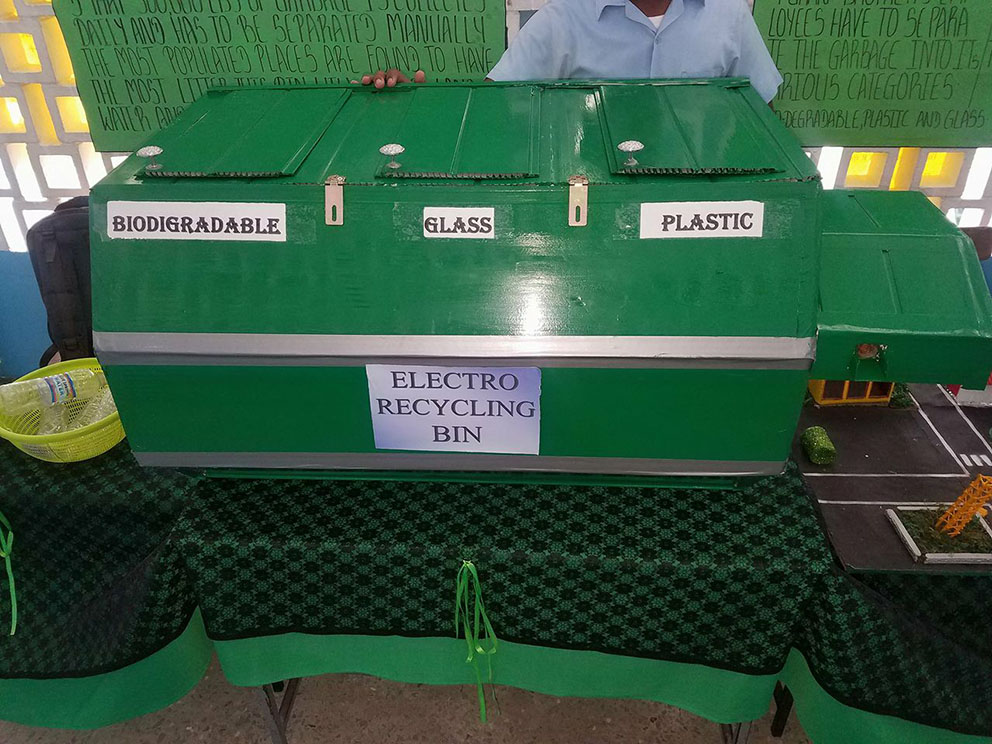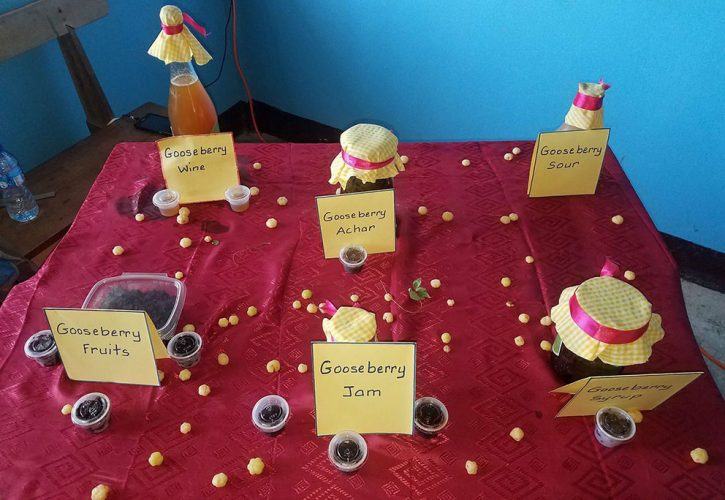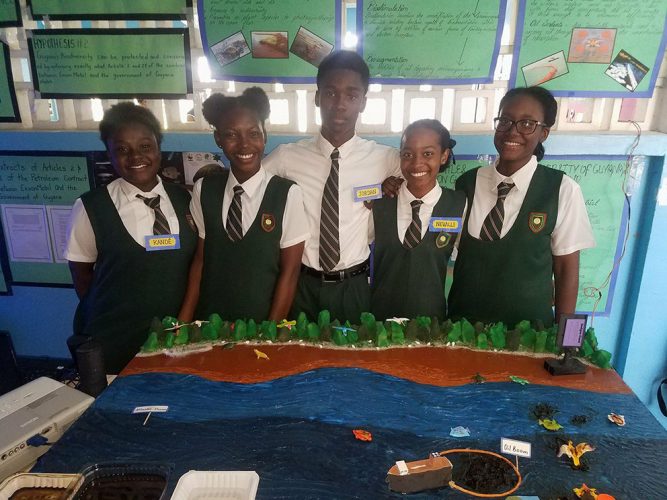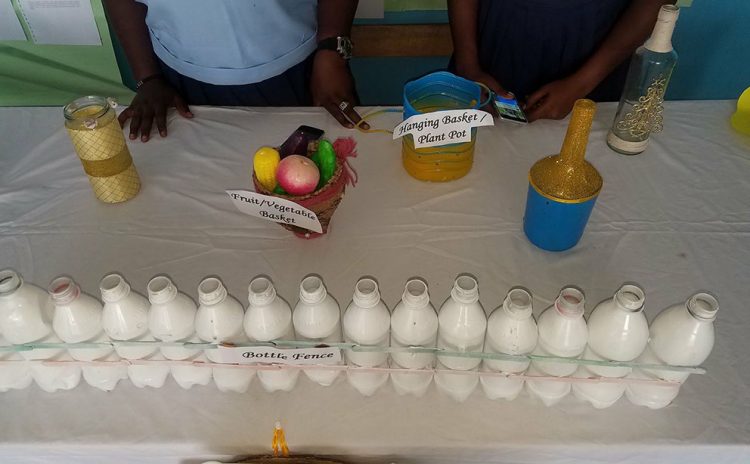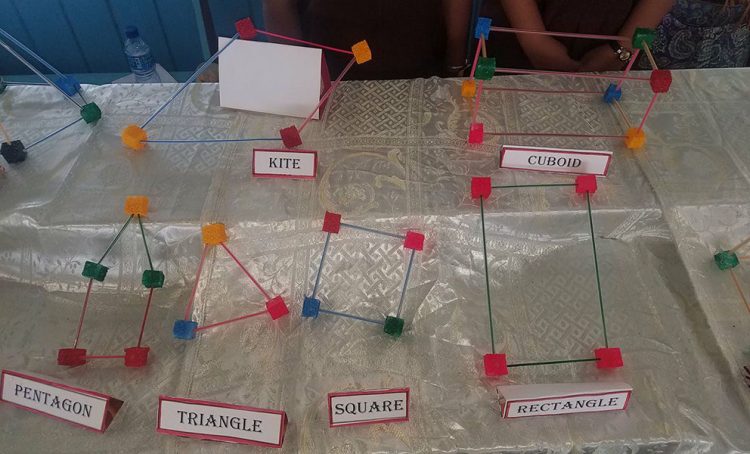The 14th national biennial science fair continued yesterday with judges examining entries from schools all across the country ranging from a recycling bin that distributes rewards to the multi-purpose use of the tangy gooseberry fruit.
The Science, Technology, Engineering, Arts and Mathematics (STEAM) fair opened on Wednesday and winners are to be announced today.
Spectators and judges walked along the corridors of the St. Joseph High School which were lined with projects. One spectator, Fayon Noble said “The projects were very innovative, the children thought outside the box, they didn’t just do something that was simple and they put their all into it, I think that’s a good thing”.
A group of students from St Joseph High who were there as they had holiday classes, stated that they were very impressed by the ideas and creative execution of the projects from the schools and pointed out their favourite project as Diamond Secondary School’s Electro Bin.
Diamond Secondary School students were elated to have their project on display and are positive that they would be able to win the competition. Their project focused on pollution in Guyana. “Our school uses about 100 bottles per day, five days in a school week is 500 bottles per week, just imagine the amount of garbage in Guyana, it can take us to the moon and back” said Romario Persaud as he engaged visitors to the exhibits. He stated that his team made contact with Puran Brothers and found out that about 300,000 pounds of garbage is collected per day in one village.
“We created this bin to help to reduce that number and decrease the amount of garbage found in the streets. We also found out from Puran Brothers that the garbage that they collect is not separated and everything is dumped together.”
The bin has three compartments for biodegradable waste, glass and plastic. “Let’s say you use a compartment from our bin. When you throw the plastic bottle in the bin, a token shoots out, now the token that shoots out entitles you to a free cone at Demico, so as you help us throw away garbage correctly, you gain rewards.”
The project took them about two weeks to put together. The students seemed very confident in their enterprise and said that it is not just a project, but something that can be implemented to make Guyana a cleaner, greener country.
In the Mathematics category, C.V. Nunes Primary School from Anna Regina had on display models of shapes. A student of the school, Givasha Harpaul stated that they came up with the idea for their project after noticing some children having problems understanding and counting, edges, vertices and faces of shapes.
“We decided if they make the shapes, they will learn while having fun at the same time.” Harpaul and her colleague Lakshna Kishoor came up with the idea and were supervised by a teacher. Both girls said that the most fun part of putting the project together was spray painting the materials. The girls also said they were nervous but still very excited.
Ramona Beveny and Naisha Calder of Buxton Secondary School showed off their presentation which was focused on flood resilience in the Buxton/Friendship village. Beveny said “Too much solid waste has been thrown in the gutter, so instead of throwing the solid waste in drains, we can recycle them to make various things.” Their display contained, baskets, vases and wreaths, made from various recycled materials including plastic bottles, champagne bottles and toilet paper rolls.
“We have looked at a way of reducing flooding and beautifying their homes with reusable materials.” They were excited to be showcasing their idea as it is their first year in the competition and they hope to learn as much as possible to return to the competition next year.
One of the Bishops’ High School’s entries in the competition focused on the future as Guyana is set to become an oil producing country. Their research was based on the effects of an oil spill on Guyana’s coastline, ecosystem and society as a whole.
Jordan Kelman stated “We tried to look at pollutants and stuff that would affect our ecosystem, our biodiversity is a prized possession of Guyana, and if we are willing to just disregard their importance because we found oil, we do not deserve to be called Guyanese citizens”.
Kelman also spoke about the ways that the country can deal with an oil spill. They did research on two ways, being the mechanical method, which included the usage of apparatus such as booms (a temporary floating barrier used to contain an oil spill) and sorbents to contain and get rid of oil from the surface of the water. The biological method which Kelman stated may be slow and somewhat unreliable, would be the usage of microorganisms to combat oil slicks, these break the oil down. “This only works at a one percent efficiency naturally, which simply means that we may be seeing progress in maybe 10-20 years.”
Aaliyah Calder of Belladrum Secondary based her project on the gooseberry. They thought of the idea after noticing that this and other fruits are wasted in their community. “Gooseberry can be used to make many different things, instead of wasting the fruit, you can make jams, achar and sour. Like if you don’t have a job this can be a good thing to do to make some money and making use of a fruit that is usually wasted.”
On their display they had products all made from gooseberries including wines, sour, syrup and jam. Calder stated that she feels good about the competition and she hasn’t seen any other project like hers.
The winners of the STEAM Fair are expected to be announced today when the fair comes to a close.
